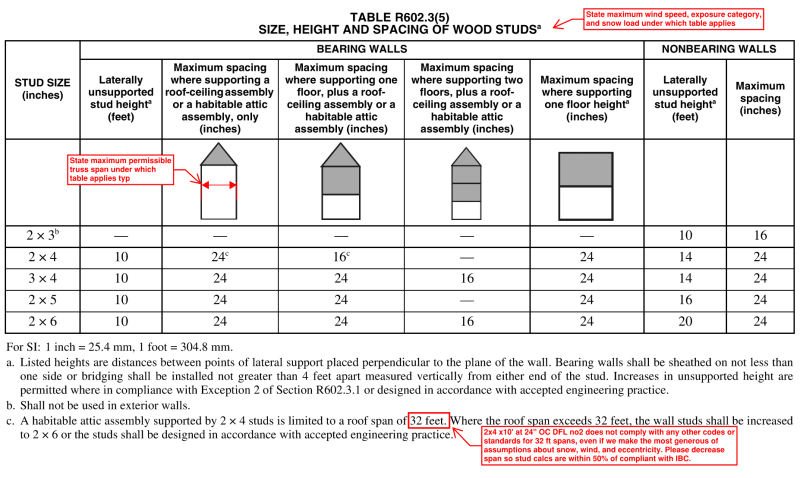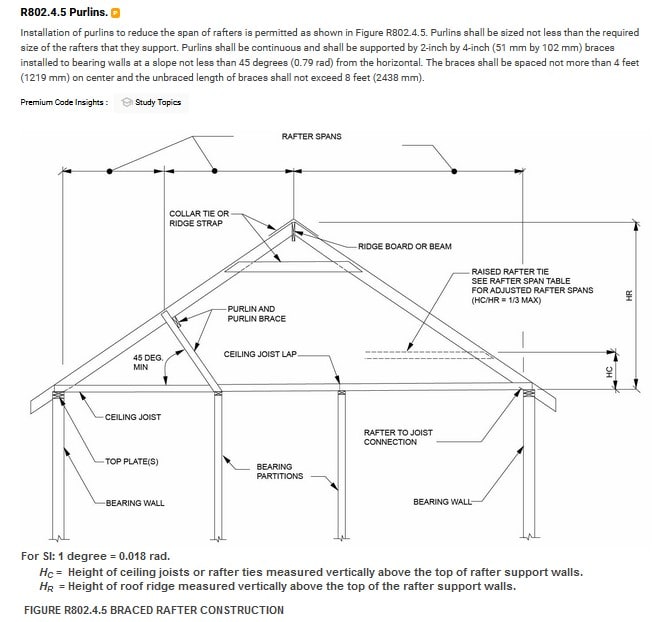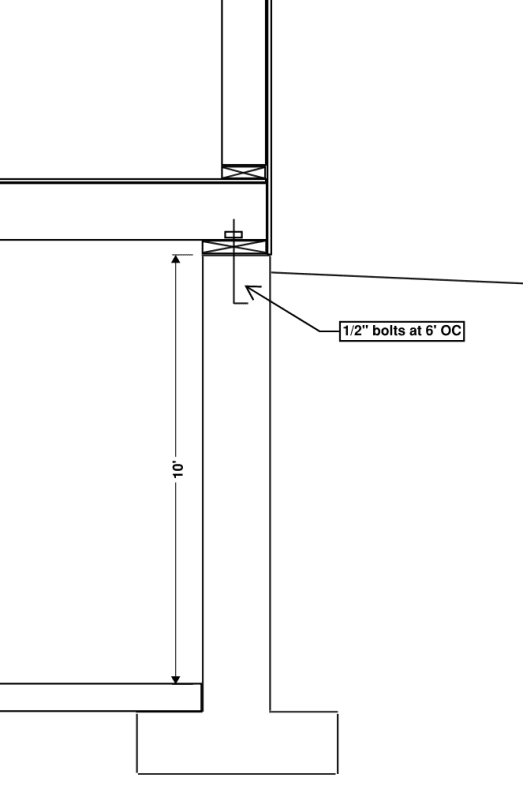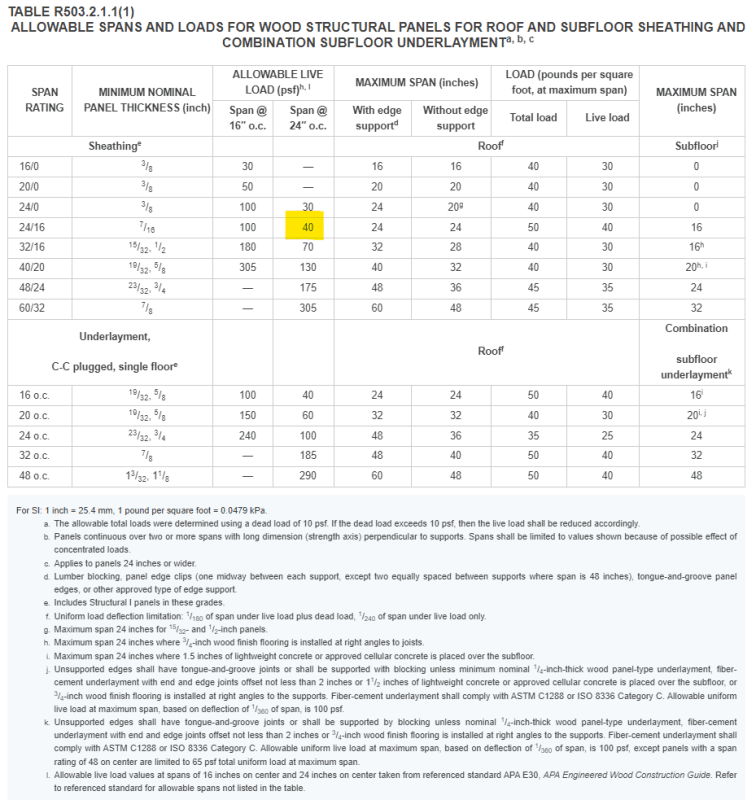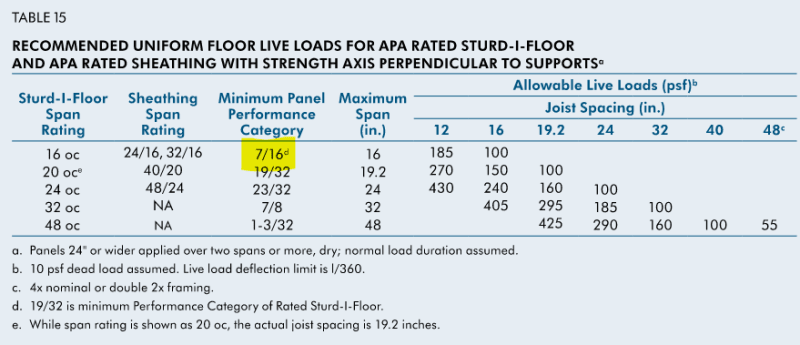Preamble: This is going to meander a bit, sorry, it's about 2 am here. Also, I'm really mixing the years here, 2018 NDS, 2000 International Residential Code... if anybody wants to cross reference and see where any of these tables may have moved to if they've been renumbered in the last 20+ years, do please feel free. I'm not looking at the 2000 IRC to be stubborn or anything, it's just what I have open at the moment.
@StrEng007 - I'm not convinced light gauge steel framing is popular outside Florida, so there's maybe not much need for the lower wind loads, but it's in the prescriptive code, never seen it used personally. You could use the WFCM for petty high wind loads, but again, wood isn't popular in that part of Florida for a house, even. I keep hearing masonry is the thing. I thought ICC 600 was for storm shelters, I guess not, haven't much seen it or used it. The residential code, speaking loosely, is the minimum, it's probably in most places less than what an engineered design via the IBC would produce. I don't have big bowls of calculations to show that, mind you, but given the origin of the IRC it's "what's worked fairly well" versus anything that was explicitly calculated out in say, 1926. I'd expect quite a bit of it won't calculate out strictly, but does that make is a "waste?" that you learn and can speak to the client about their expectations for IRC versus an engineered building/wall system?
@phamENG - anchorage for loads along the wall, sure, if you skip over the potential for needing a holdown at the end of the wall via the braced wall provisions, sure, but for a soil lateral load, well, Mike Mike has more on that point.
I feel like you're missing a ribbon board on that detail at the joist, Mike Mike, but it's not critical to the discussion at hand.
On the 52' span, I suppose, if the rafter table gives you a 52' span, then... maybe? R802.5/1(1) (2000 IRC, sorry, that's the one I have open at the moment, but the other versions aren't insanely different...), is for dead load of 10 psf, roof live load of 20 psf (no snow), and no ceiling (L/180 deflection), Even so, that's a 12" joist spacing, DFL select structural, not something you'll usually get in quantity, given the 26' length you need.
I mean, yeah, for a ceiling joist versus a vaulted ceiling, I suppose, you need a ceiling joist, too, though, which is another DF ss, 26' long 12" on center. I hear rafter span (and ceiling joist span) and I think vertically supported at both ends. Maybe the residential code doesn't come out and say that, the "ridge board or ridge beam" in the drawing sure doesn't mean there's a vertical support (ridge board isn't a vertical support), but the ceiling joist, that's got to be looking for an interior wall at the 26' mark, it's not a clear span. I suppose, yeah. 52' width. I would imagine while there may be tables for the rafter to ceiling joist connection, there is probably not enough space for that many nails. Then we have the splice in the ceiling joist. That is probably going to produce a large force demand that could exceed the IRC fastening schedule, as well.
That kind of bears on the rest of the conversation, if you can put it in, but there's no space for the nailed connection? Table R802.5.1(9) has one entry where 39 16d nails are required for the connection.... that may be enough to make the connection work, but that sounds like a lot of nails in a relatively small space. You can clinch the nails to reduce the number required, but a 16d nail 0.162 x 3 1/2" per 2018 NDS, I suppose for 3" of wood (2 x 1/5") you get the 3/8" length beyond to get a legitimate clinch. (3 diameters past the side member? 12.1.6.4?) 802.3.2 requires a 3" overlap between the two ceiling joists, that's not a lot of space for nailing, at least not for a 26' long rafter each side, R602.3(1) Fastening schedule seems to call for 3-10d nails there. That value never changes regardless of the rafter to ceiling joist connection.....
On the bolt at the top of the masonry wall - wouldn't you need preservative treated wood there for the sill, so DF or SP, not HF?
Look at the 2000 International Residential Code, R603.2.1, point one, not parentheses 1. You're looking at a fastening table, the table I'm talking about (back when) was called Maximum Allowable Length (THEY should say height? Okay maybe not) of Wood Wall Studs,.... 100 mph, SDC A, B, C, or D
1 (snow load 25 psf or less.... provided the F
b multiplied by the repetitive stress is 1,310 or more. That's where the MOE requirement was, like I said it might have gotten deleted.
Per
2018 National Design Specification, Supplement:
Sitka Spruce, Select Structural, 1,600,000 psi MOE
Beech Birch Hickory, Select Structural and Grade #1,
Coast Sitka Spruce, Select Structural,
DFL #2 or better,
Hem Fir Select Structural,
Hem Fir (north) #2 and better,
Red Maple #1 or better
Yellow Cedar select structural
Nothing one usually constructs with, unless you're going to count DF #1 which I'd rather doubt is a typical stud in say, California.
I kind of wonder if you can get a 2x4 stud to work for that 26' span of roof above it. Is that an 8' height, then?
There's just so many provisions, I'd be really surprised if EVERYTHING was per code in any given building. Let alone the footnotes, and the longer the code gets, the less likely it's "perfect".
I want to say that the sill bolting at 6' is for the load in the braced wall along the length of the wall (into the page, from wind/seismic). When it comes to the bracing effect of the top of wall versus the retained soil (perpendicular to the wall), the code .. might not know about it. There's maybe other provisions elsewhere for anchor bolt spacing due to the lateral (soil) load with C
D = 0.9 in there somewhere, or the code gives a reaction at the top of the wall that's supposed to be "designed for" (by whom?).
I'm not convinced there's "cheaper" available via an engineered design, and I'm not overly excited about putting an engineered system in the middle of two prescriptive designs and calling that good. We have load path requirements, after all (R301.1), (
The IRC – Does It Really Matter?, Young, Structure Magazine, November 2019). So the connections and the elements to which your engineered design attach to and interact with are supposed to be proven valid to some degree. You wouldn't attach an 8,000 pound holdown into floor blocking in a commercial building, after all, it's supposed to be connected to something that's good for resisting the load.
I think you get into more ethical exposure when you know something is 18x over the engineered limit and don't point it out. Phil, Reid Middleton, and the Washington building officials are VERY active on foundation walls every IRC code cycle I've seen. I don't think you are fully on the hook for not providing them a fix "for free" but failing to point it out and either say --- hey, somebody should look at that, it's way overstressed, or a) I know a few guys that could design this or b) I could.
I think the critical element here is you know (in this example) that it looks highly doubtful to work correctly as a prescriptive design, and from past experience you know it won't calculate out per an engineered standard).
The provisions themselves, don't quite seem to capture a consistent connection strategy, so I'd really hesitate to "mix and match" and put an engineered design onto a prescriptive load path. I may be the fifth dentist, or I'm one of the 4 out of five dentists. Can't be sure.

